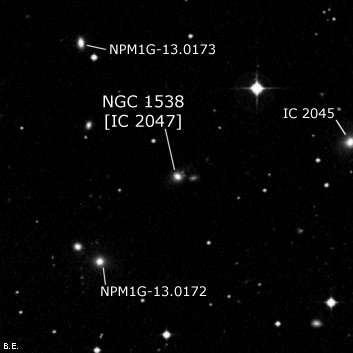
Holm 73a = LEDA 3093623 appeared faint, extremely small, round, 6" diameter (core). Forms a close pair with Holm 73b = LEDA 940994 45" NE. The companion is extremely to very faint, also just 6" diameter (core).
IC 2045 (identified as NGC 1538 in RNGC and PGC) appeared fairly faint, small, slightly elongated, 20" diameter, very small slightly brighter core. IC 2045 is the brightest in a small group including IC 2047 5' ESE and Holmberg 73 (pair) 8' ESE. With my 17.5" on 12/30/99, IC 2045 was logged as faint, very small, round, 20" diameter, weak concentration. Situated between a mag 10 star 3' NE and a mag 9 star 5.5' SW.
Herbert Howe discovered IC 2047 = Ho. III-15 on 20 Jan 1900 and reported "eF, eS, difficult; near [NGC 1538]." His position matches LEDA 941480. Howe assumed Holm 73a = LEDA 3093623 was NGC 1538 as it is the closest galaxy to Stone's (rough) position. But Harold Corwin, who examined Stone's sketch, states that IC 2047 is a better match with the sketch. This implies Stone missed IC 2045 (also found by Howe), which is the brightest of the galaxies in this field. So, we are left with three possible candidates for NGC 1538 and the identification is uncertain.
600/800mm - 24" (12/22/14): faint, small, round, 12" diameter (core only), very faint stellar nucleus. Holmberg 73 (double system) lies 3.3' SE and IC 2045 is 5.0' WNW.
Notes by Steve Gottlieb